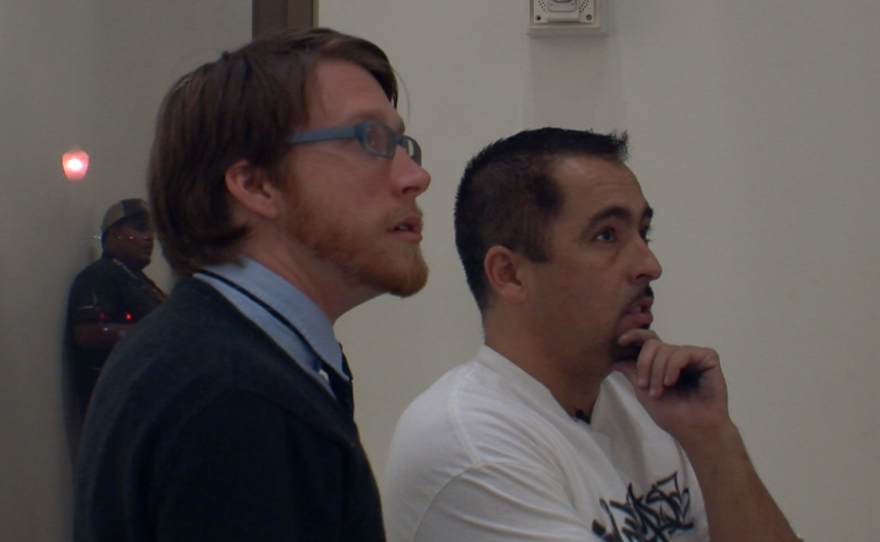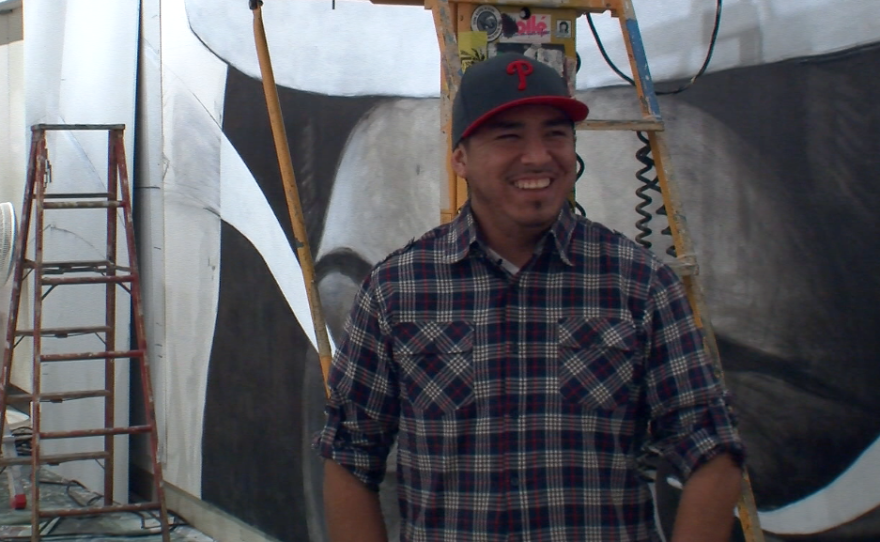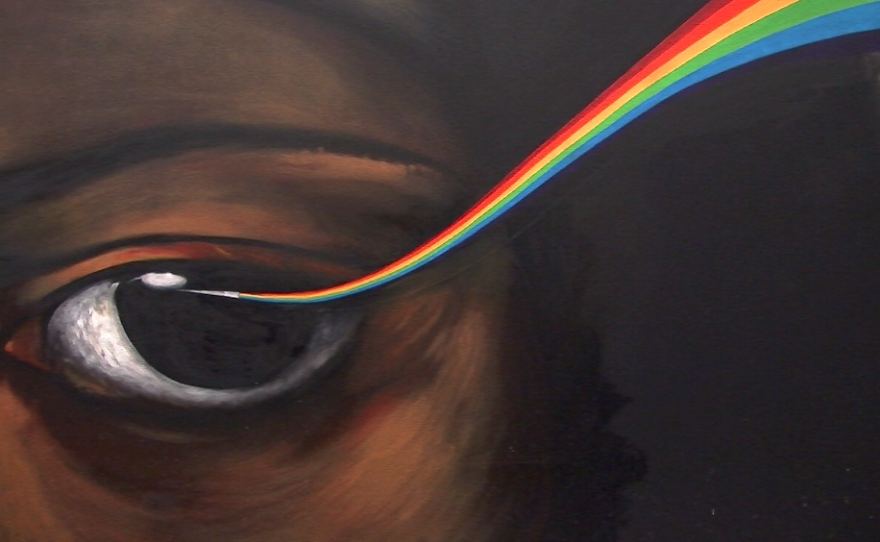HOST INTRO: The San Diego Museum of Art just opened an exhibition on modern Mexican painting. Part of the exhibit is a new mural commissioned by the museum and involving graffiti artists. KPBS arts reporter Beth Accomando looks at the collaboration between the museum and Writerz Blok. Alexander Jarman's job is to help people understand art. So what better way to convey what goes into creating murals like the ones by Diego Rivera than to commission a mural to go up in the museum so people can watch its progress. Jarman teamed with Writerz Blok to have a group of graffiti artists riff on images from the museum's exhibit on Mexican Modern Painting. ALEXANDER JARMAN: Obviously we are going to get some questions about pairing Diego Rivera imagery with graffiti. Jarman is the Public Programs Manager at the San Diego Museum of Art. He wanted to bring muralism to the 21st century for museum patrons. Graffiti is a key part of this urban muralism and the street art finds itself in an interesting position in relationship to institutions right now. ALEXANDER JARMAN: The very nature of doing graffiti, the very act of going out there and taking over a wall is a political act because it talks about what space belongs to who and what kind of messages we want to see being communicated to us. But what happens to this rebellious art form when it's taken into a mainstream setting? ALEXANDER JARMAN: It definitely changes it when it comes inside the institution but that only makes it different. It doesn't necessarily make it better or worse, it's just a different context for it. That's where Writerz Blok comes in. The organization works to change the perception of graffiti as a criminal activity and to see that it is an art form that can be turned into a career. Sergio Gonzalez started with Writerz Blok in 1990 as a youth who was part of the problem. Now he's an adult mentoring a new generation of kids. He doesn't think any of the artists working on the mural are losing any of their street cred by working inside a museum setting. SERGIO GONZALEZ: They've proven what they've done on the streets. And I mean these guys have matured to be well distinguished artists now and it's finally time for them to be showcased that way. Artists like Israel Serrano are thrilled to find themselves in a museum setting where on the other side of the wall he's painting there are works by Rivera, Picasso, and Dali. ISRAEL SERRANO: It's awesome. It's a once in a lifetime thing so we're just enjoying it. Hopefully the chance comes around again but we're trying to make the best of this one. The lead artist on the mural is Saratoga Sake. Rather than just copying images from the exhibit, he wanted to do a surrealist homage to painters like Diego Rivera. SARATOGA SAKE: I wanted the Hands of Dr. Moore by Diego Rivera to be like the hands of god like Diego is like the creator of the mural movement and this woman's head is almost like the shape of the world and I want to have a rainbow of color shooting out of her eye and that's where the graffiti will start. Sake has been painting for more than 2 decades and has struggled with trying to find legal places to practice his art. He's a perfect example of how someone can move from illegal tagging to working in a gallery setting. He is a self taught artist who expanded his tools from just a spray can to brushes and oils. For the mural he'll mix graffiti with fine art techniques for the first time. For the bulk of the wall, Sake turned to Flemish techniques from centuries ago. This involved only shades of black as the first layer of the mural. SARATOGA SAKE: I drew everything first with charcoal and then I'm doing light washes on top of it. The under painting does all the magic and you just paint right over it real lightly. Sake says he used to be snobbish about art hanging in museums. He didn't think he could learn anything from them... until he saw them firsthand. SARATOGA SAKE: There's more out there than just graffiti and I think that made me a better graffiti artist being more open to all sorts of art. Seeing paintings I had seen in books before they didn't look as how they looked in books, they looked, wow! That's precisely the feeling Alexander Jarman wants to elicit from people coming to the museum and seeing the mural from Writerz Blok. ALEXANDER JARMAN: Nothing replaces having an experience with the art right in front of you. Seeing the impressive 70 foot mural up close may be exactly the type of intimate experience that will bring people around to appreciating graffiti as a fine art. For KPBS News, I'm Beth Accomando.
The San Diego Museum of Art commissioned a mural that takes images from their new exhibit, Mexican Modern Painting, and has them interpreted by graffiti artists from Writerz Blok. The mural, which was officially unveiled last night, offers these artists a rare opportunity to display their work in a gallery setting.
Alexander Jarman's job is to help people understand art. So what better way to convey what goes into creating murals like the ones by Diego Rivera than to commission a mural to go up in the museum so people can watch its progress. Jarman teamed with Writerz Blok to have a group of graffiti artists riff on images from the museum's exhibit on Mexican Modern Painting.
"Obviously we are going to get some questions about pairing Diego Rivera imagery with graffiti," says Jarman who is the public programs manager at the San Diego Museum of Art. He wanted to bring muralism to the 21st century for museum patrons. Graffiti is a key part of this urban muralism and the street art finds itself in an interesting position in relationship to institutions right now.

"The very nature of doing graffiti," he says, "The very act of going out there and taking over a wall is a political act because it talks about what space belongs to who and what kind of messages we want to see being communicated to us."
But what happens to this rebellious art form when it's taken into a mainstream setting?
"It definitely changes it when it comes inside the institution," states Jarman, "But that only makes it different. It doesn't necessarily make it better or worse, it's just a different context for it."

That's where Writerz Blok comes in. The organization works to change the perception of graffiti as a criminal activity and to see that it is an art form that can be turned into a career. Sergio Gonzalez started with Writerz Blok in 1990 as a youth who was part of the problem. Now he's an adult mentoring a new generation of kids. He doesn't think any of the artists working on the mural are losing any of their street cred by working inside a museum setting.
"They've proven what they've done on the streets," Gonzalez says, "And I mean these guys have matured to be well distinguished artists now and it's finally time for them to be showcased that way."
Artists like Israel Serrano are thrilled to find themselves in a museum setting where on the other side of the wall he's painting there are works by Rivera, Picasso, and Dali.
"It's awesome," enthuses Serrano, "It's a once in a lifetime thing so we're just enjoying it. Hopefully the chance comes around again but we're trying to make the best of this one."

The lead artist on the mural is Saratoga Sake. Rather than just copying images from the exhibit, he wanted to do a surrealist homage to painters like Diego Rivera.

"I wanted the Hands of Dr. Moore by Diego Rivera to be like the hands of god since Diego is like the creator of the mural movement," Sake explains as he shows me the mural, "And this woman's head is almost like the shape of the world and he's injecting the tree of life into her and cutting off a [tree] limb and I want to have a rainbow of color shooting out of her eye and that's where the graffiti will start."

Sake has been painting for more than 2 decades and has struggled with trying to find legal places to practice his art. He's a perfect example of how someone can move from illegal tagging to working in a gallery setting. He is a self taught artist who expanded his tools from just a spray can to brushes and oils. For the mural he'll mix graffiti with fine art techniques for the first time. Because of the dangers the aerosol paint poses to the museum's paintings he could not use spray paint inside the museum itself. The graffiti would instead be created on panels painted outdoors. For the bulk of the wall, Sake turned to Flemish techniques from centuries ago. This involved only shades of black as the first layer of the mural.
"I drew everything first with charcoal," describes Sake, "And then I'm doing light washes on top of it. The under painting does all the magic and you just paint right over it real lightly."
Sake says he used to be snobbish about art hanging in museums. He didn't think he could learn anything from them... until he saw them firsthand.
"There's more out there than just graffiti," Sake says, "And I think that made me a better graffiti artist being more open to all sorts of art. Seeing paintings I had seen in books before they didn't look as how they looked in books, they looked, wow!"
That's precisely the feeling Alexander Jarman wants to elicit from people coming to the museum and seeing the mural from Writerz Blok: "Nothing replaces having an experience with the art right in front of you."
Seeing the impressive 70 foot mural up close may be exactly the type of intimate experience that will bring people around to appreciating graffiti as a fine art.
Check out my Evening Edition video:
Below are a series of videos that I produced, wrote, and edited in 1991 when I was working in promotions at Fox XETV Channel 6. I hired 8 aerosol artists to put up walls promoting the Fox programming. The artists were Sake, Vapor, Quasar, Chino, Dyse, Sero, Jesse "Bustone" Ortiz, and Ricahrd Martinez. Sake created the image of Homey the Clown and to this day I remember how three-dimensional Homey's nose looked -- it popped off the wall like a bowling ball. All the artists were amazingly talented, and I am thrilled to see Sake and Vapor still painting and finally reaping some rewards for their artistry.






